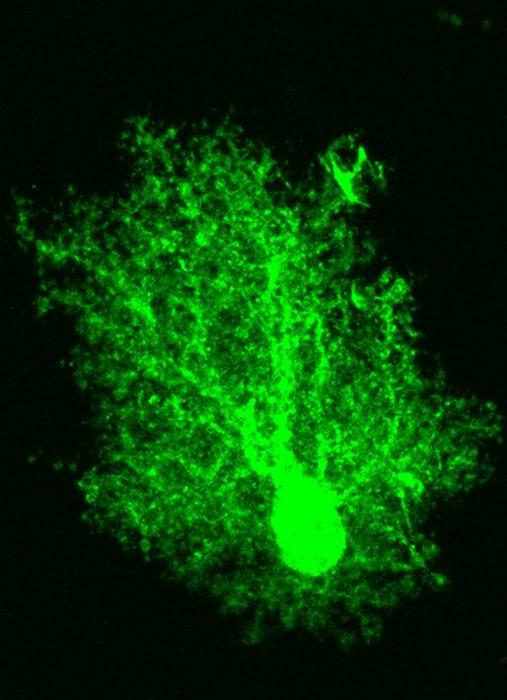In a groundbreaking revelation that challenges long-standing neuroscience paradigms, researchers at Washington University School of Medicine have uncovered a novel mechanism by which norepinephrine—a critical neuromodulator—exerts its influence on brain circuitry. Contrary to the conventional belief that norepinephrine acts directly on neurons, this study illuminates the indispensable role of astrocytes, a type of glial cell previously relegated to a supportive status, in modulating synaptic activity and brain connectivity. This discovery not only reshapes our fundamental understanding of neural communication but also opens new avenues for therapeutic interventions targeting cognitive and emotional disorders.
For decades, neuroscience textbooks have perpetuated the notion that neuromodulators like norepinephrine fine-tune neural circuits through direct action on neurons, the electrically excitable cells responsible for fast synaptic transmission. Yet, the WashU Medicine team, led by Dr. Thomas Papouin, employed an array of sophisticated experimental techniques, including selective stimulation of norepinephrine secretion in murine models and acute brain slice methodologies, to reveal a more intricate interaction. These experiments demonstrated that while norepinephrine does modulate neuronal synapses, the presence and activity of astrocytes are essential mediators of this effect, underscoring a pivotal paradigm shift.
Astrocytes, characterized by their star-shaped, highly ramified processes, have traditionally been considered passive support cells. However, over the past three decades, accumulating evidence has suggested that astrocytes intimately associate with synapses, modulating neurotransmission and synaptic plasticity. Their unique morphology permits them to envelop numerous synapses, positioning them to monitor the extracellular milieu and respond dynamically to neurochemical signals. This recent study extends that knowledge by establishing a direct causal link between norepinephrine’s neuromodulatory capacity and astrocyte-mediated signaling cascades.
Experimental findings revealed that norepinephrine triggers astrocytic activation, which in turn leads to the release of a secondary chemical messenger that effectively dampens synaptic transmission. Importantly, when the ability of neurons to directly sense norepinephrine was experimentally abrogated, the modulation of synapses persisted, reinforcing the notion that astrocytes are the principal conduits for norepinephrine’s modulatory actions. Conversely, silencing astrocytic responsiveness to norepinephrine abolished these effects, thereby highlighting the necessity of astrocyte-neuromodulator interactions in the regulation of synaptic efficacy.
This astrocyte-dependent neuromodulation occurs over slower timescales compared to direct neuronal signaling, suggesting a complex, multi-temporal orchestration of brain activity that has been underappreciated until now. Such temporal dynamics may underpin processes requiring sustained attention and cognitive flexibility, functions traditionally attributed to fast neurotransmitter systems. The implications for neuropsychiatric disorders are profound, particularly considering that many cognitive dysfunctions reflect aberrations in neuromodulatory systems.
Dr. Papouin and his group propose that astrocytes, far from being mere bystanders, are active architects in the remodeling of brain networks during states of heightened vigilance and attention. This astrocytic involvement could explain some of the subtleties and resilience observed in synaptic plasticity, especially under conditions where neuromodulatory tone fluctuates. By elucidating this mechanism, the research provides a vital framework for revisiting therapeutic strategies aimed at enhancing cognitive function or ameliorating attentional deficits.
In light of these findings, the researchers have embarked on investigative efforts to reassess the mechanisms of existing pharmaceuticals that target norepinephrine signaling, commonly prescribed for conditions such as attention deficit hyperactivity disorder (ADHD) and depression. It remains an open question whether the efficacy of these drugs is contingent upon astrocytic functions. If so, designing treatments that directly harness astrocyte biology could herald a new class of interventions with potentially improved efficacy and specificity.
Furthermore, this study highlights the broader neuroscientific importance of glial cells in brain health and disease. Whereas neurons have historically dominated research focus, astrocytes and other glial cells are increasingly recognized for their crucial roles in maintaining homeostasis, modulating synaptic function, and shaping neural circuits. This shift towards glia-centric neuroscience may unravel previously unexplained facets of brain complexity and neuropathology.
Critically, the experimental design implemented by the WashU team combined optogenetics, calcium imaging, and pharmacological manipulation to parse the sequence of events from norepinephrine release to synaptic modulation. Observations that astrocyte activation precedes synaptic dampening indicate a direct signaling pathway, challenging earlier models that posited a direct neuron-to-neuron neuromodulatory route. These technical advancements solidify the robustness of their conclusions.
The translational potential of harnessing astrocyte-mediated pathways extends beyond cognitive disorders, possibly influencing strategies for memory enhancement and emotional regulation. Because astrocytes can integrate diverse neurotransmitter signals and modulate synaptic outputs accordingly, targeted modulation of their activity represents a frontier in neurotherapeutics that could complement or supersede existing neuron-focused treatments.
In sum, the discovery that norepinephrine operates through astrocytes to govern synaptic dynamics compels a reevaluation of brain function dogma. It underscores the complexity of neurochemical interactions and the essential role of glial cells in orchestrating neural networks. This insight not only propels forward the scientific understanding of brain circuitry but also sets the stage for innovative approaches to neurological and psychiatric care, transforming astrocytes from passive bystanders into active protagonists of brain health.
Subject of Research: Animal tissue samples
Article Title: Norepinephrine signals through astrocytes to modulate synapses
News Publication Date: 15-May-2025
Web References: https://www.science.org/doi/full/10.1126/science.adq5480
References: Lefton KB, Wu Y, Dai Y, Okuda T, Zhang Y, Yen A, Rurak GM, Walsh S, Manno R, Myagmar B-E, Dougherty JD, Samineni VK, Simpson PC, Papouin T. Norepinephrine signals through astrocytes to modulate synapses. Science. May 15, 2025. DOI: 10.1126/science.adq5480
Image Credits: IMAGE COURTESY YIFAN WU
Keywords: Neuroscience, Astrocytes, Neuronal synapses




